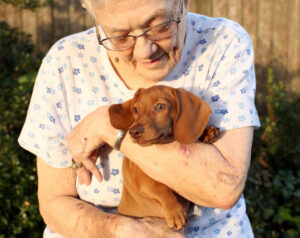Young puppy, senior years

Many seniors buy or adopt young dogs for companionship. They’ve had dogs all their lives, love them, and see no reason why this should change. This blog is not about whether seniors should buy or adopt young dogs — they will. It offers suggestions on what to do once they have.
1. Make sure the dog is confined and supervised, either during puppyhood or during the first 30 days post adoption. Introduce the dog gradually to home life, offering freedom only as the new family enjoys days without house training accidents. Many seniors may remember days with previous dogs that lived with them unsupervised, so crate training, use of an exercise pen, and the reason why a new dog must be supervised may need to be emphasized.
2. Find a place where the dog may exercise and benefit from social time, as the routine and daily regime of most seniors does not adequately stimulate a young dog. Ensure that the new parent understands that puppies benefit from an abundance of socialization prior to their 20th week of age. Young dogs in gated communities often suffer from the benign neglect of too much house and too few canine companions. Adorable and easy as puppies, they mature into lively yappers that will bedevil even the most patient dog walker. Seniors that want to enjoy peaceful walks with happy dogs would do well to invest in training and day care when the puppy is young (12-20 weeks of age).
3. As the dog grows from puppy to adolescent, continue to seek avenues for exercise and socialization. Dog daycare or day training offers ways for dogs to learn and play that do not tax a senior’s capacity for exercise and attention. A tired puppy is less likely to bark or nip for attention.
4. Explore group classes with an eye to the senior’s ability and interests. Many seniors asks me about agility — but it has been years since they have exercised, much less sprinted, changed direction quickly, etc. Nose work or barn hunt are good choices for many, as the dog works independently (no obedience required) and the handler doesn’t need to run or be fit. Having someone teach a dog to swim or play fetch will also empower seniors to exercise the dog in a way that suits their ability. Don’t let the senior say that walking the puppy will get them into shape — a fall or dislocated shoulder is a serious matter, and puppies don’t come with an off switch, or know not to dart in front of someone to chase a lizard.
5. Be patient. Puppies and young dogs take time to house train, and training solutions to common problems work, but have to be pursued until they do. Compliance is key — good dog trainers know the science behind their suggestions. Don’t assume that Trainer Google or Famous TV Dog Trainer knows best.
6. Think about your choices, and be ready to revisit them. A Golden Retriever puppy purchased at 75 years of age will be a different experience than one rescued at 40. If you are in over your head, be fair to the dog, and consider owner surrender to rescue, family, or friends. The age of the dog matters — dogs are easier to socialize, train, and/or rehome when they are young.
7. Senior people may be happy with senior dogs. An older dog may be a wise choice. Senior dogs are calmer, often house broken, and less likely to chew and destroy household items. They may be available because their person has died, or because the kids wanted a puppy. Consider all of your options — even better, downsize. The Golden Retriever lover may find a way to adore an older Cavapoo or Bichon.
